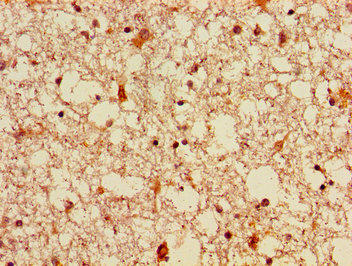Description
| Antibody Name: | FGF22 Antibody (PACO54774) |
| Antibody SKU: | PACO54774 |
| Size: | 50ug |
| Host Species: | Rabbit |
| Tested Applications: | ELISA, IHC |
| Recommended Dilutions: | ELISA:1:2000-1:10000, IHC:1:20-1:200 |
| Species Reactivity: | Human |
| Immunogen: | Recombinant Human Fibroblast growth factor 22 protein (23-170AA) |
| Form: | Liquid |
| Storage Buffer: | Preservative: 0.03% Proclin 300 Constituents: 50% Glycerol, 0.01M PBS, pH 7.4 |
| Purification Method: | >95%, Protein G purified |
| Clonality: | Polyclonal |
| Isotype: | IgG |
| Conjugate: | Non-conjugated |
 | Immunohistochemistry of paraffin-embedded human brain tissue using PACO54774 at dilution of 1:100. |
| Background: | Plays a role in the fasting response, glucose homeostasis, lipolysis and lipogenesis. Can stimulate cell proliferation (in vitro). May be involved in hair development. |
| Synonyms: | Fibroblast growth factor 22 (FGF-22), FGF22 |
| UniProt Protein Function: | FGF22: Plays a role in the fasting response, glucose homeostasis, lipolysis and lipogenesis. Can stimulate cell proliferation (in vitro). May be involved in hair development. Belongs to the heparin-binding growth factors family. |
| UniProt Protein Details: | Protein type:Secreted, signal peptide; Secreted Chromosomal Location of Human Ortholog: 19p13.3 Cellular Component: Golgi apparatus; extracellular space; cell surface; extracellular region; nucleolus Molecular Function:growth factor activity; fibroblast growth factor receptor binding Biological Process: epidermal growth factor receptor signaling pathway; phosphoinositide-mediated signaling; fibroblast growth factor receptor signaling pathway; nerve growth factor receptor signaling pathway; insulin receptor signaling pathway; innate immune response; cell differentiation |
| NCBI Summary: | The protein encoded by this gene is a member of the fibroblast growth factor (FGF) family. FGF family members possess broad mitogenic and cell survival activities and are involved in a variety of biological processes including embryonic development, cell growth, morphogenesis, tissue repair, tumor growth and invasion. The mouse homolog of this gene was found to be preferentially expressed in the inner root sheath of the hair follicle, which suggested a role in hair development. Alternative splicing results in multiple transcript variants. [provided by RefSeq, Jul 2014] |
| UniProt Code: | Q9HCT0 |
| NCBI GenInfo Identifier: | 13626689 |
| NCBI Gene ID: | 27006 |
| NCBI Accession: | Q9HCT0.1 |
| UniProt Secondary Accession: | Q9HCT0,B2RPH4, |
| UniProt Related Accession: | Q9HCT0 |
| Molecular Weight: | 19,663 Da |
| NCBI Full Name: | Fibroblast growth factor 22 |
| NCBI Synonym Full Names: | fibroblast growth factor 22 |
| NCBI Official Symbol: | FGF22 |
| NCBI Protein Information: | fibroblast growth factor 22; FGF-22 |
| UniProt Protein Name: | Fibroblast growth factor 22 |
| Protein Family: | Fibroblast growth factor |
| UniProt Gene Name: | FGF22 |
| UniProt Entry Name: | FGF22_HUMAN |
| Antibodies | ELISA Kits |
| FGF22 Antibody (PACO00801) | Human FGF22 (Fibroblast growth factor 22) ELISA Kit (HUFI08180) |
| Secondary Antibody |
| Anti-HRP Goat Anti-Rabbit IgG (H+L) Antibody (CABS014) |
| Recommended Products |
| Anti-FITC Goat Anti-Rabbit IgG (H+L) Antibody (CABS011) |
| Anti-HRP-conjugated Beta Actin Antibody (CABC028) |






